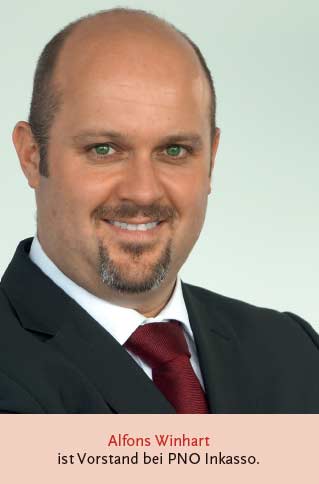Receivables Management 4.0
![[shutterstock.com:580162816, Tashatuvango]](https://e3mag.com/wp-content/uploads/2017/02/shutterstock_580162816.jpg)

 From a technical point of view, the requirements for an automation project are clearly limited. An ERP, BuHa or OPOS solution is required.
From a technical point of view, the requirements for an automation project are clearly limited. An ERP, BuHa or OPOS solution is required.
Whether it is an existing enterprise resource planning software, accounting solution or open item management, which is then extended via the collection interface, or a new acquisition, is basically irrelevant.
The implementation effort remains the same. The transfer interface itself can be programmed from any solution.
The "Interface Inkasso" was developed for SAP, which enables the transfer. The secure data export works directly after programming, and inventory data can be used immediately for the external dunning process.
The second part of the technical integration is the information return. All data on processing progress in dunning flows back into the ERP, BuHa or OPOS software via the bidirectional interface.
There, they can be accessed by the user via the administration interface in the corresponding module. All relevant information is thus available in real time for each individual payment-impaired case.
Organization
On the organizational side, questions arise about the personnel structure, the distribution of tasks and the right project communication.
This concerns the technical implementation itself (in-house or external), the changed workflow with regard to the dunning process and, of course, information management: Who needs to know what and when?
In addition, the question arises as to where in the company an automated dunning system will be suspended in the future. Will the tasks in the accounting department change, so that the case transmission will take place from the OPOS management? Or will the topic migrate to IT?
After all, it's about goal-oriented staff training and also about passing on information to other stakeholders, such as suppliers, customers or shareholders.
Costs and benefits
The cost-benefit calculation can be broken down to a single question: Is the cost savings from automation greater than the costs it incurs?
A well-founded answer to this question then depends in turn on a total of three factors: First, there are no transition and parallel costs because the automation functions immediately on a fixed cut-off date.
This does not mean a gradual change, but a binary system. Automated or not automated.
Secondly, automation has a direct effect on personnel costs. Employees who were previously functionally and time-bound for the in-house execution of the dunning process are freed up for new tasks and can thus attend to the core business.
Thirdly, automation improves working capital. Alongside improved purchasing conditions and optimized warehouse logistics, stringency in the dunning process is one of the key business management levers.
Project plan & implementation
A rough project plan can be outlined for most automation projects as follows, although there are certainly differences in detail.
- Researching an automated receivables management service provider to work on collections cases
- Gather information about your own software solution and determine where it makes sense to implement the collection interface (consult with the software vendor).
- Program the collection interface from your own software (either via your own IT, an external IT service provider or the software house involved)
- Defining the parameters according to which cases are transferred (dunning levels, intervention options, check criteria, etc.)
- Test interface
- Train employees in the use of the new solution, explain the reasons for the changeover and communicate them internally within the company.
- Switch interface live
Outlook
In addition to the immediate operational effects, an automated dunning system is also an investment in the future.
Quite pragmatically: In the future, it will no longer be primarily a matter of processing open items, but of seeing payment disruptions coming.
Preventive collection, so to speak. The task of the collection service provider will then be to provide his client with qualified data and reliable forecasts, and to do so in real time.
It is then a matter of selecting and, above all, interpreting the flood of data provided by credit agencies, for example.
Such qualified creditworthiness data records on each potential customer will then form a central building block in the initiation of business, and a corresponding interface will become even more important.
Companies that secure these options today are setting themselves up for the future with an automated dunning system and the corresponding collection interface.




